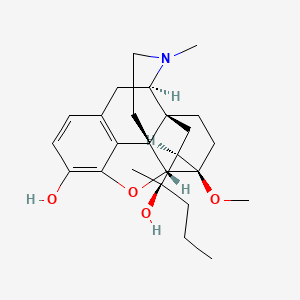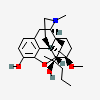Dihydroetorphine
- Dihydroetorphine
- 14357-76-7
- 18,19-Dihydroetorphine
- UNII-QQX8S479YV
- QQX8S479YV
- Create:2005-08-08
- Modify:2025-01-18

- 18,19-dihydroetorphine
- dihydroetorphine
- dihydroetorphine hydrochloride
- Dihydroetorphine
- 14357-76-7
- 18,19-Dihydroetorphine
- UNII-QQX8S479YV
- QQX8S479YV
- IDS-ND-025
- DIHYDROETORPHINE [WHO-DD]
- DTXSID60905082
- Tetrahydro-7alpha-(1-hydroxy-1-methylbutyl)-6,14-endo-ethanooripavine
- 7,8-Dihydro-7alpha-(1-(R)-hydroxy-1-methylbutyl)-6,14-endo-ethanotetrahydrooripavine
- 6,14-Ethenomorphinan-7-methanol, 4,5-epoxy-18,19-dihydro-3-hydroxy-6-methoxy-alpha,17-dimethyl-alpha-propyl-, (5alpha,7alpha(R))-
- 6,14-Ethenomorphinan-7-methanol, 4,5-epoxy-18,19-dihydro-3-hydroxy-6-methoxy-alpha,17-dimethyl-alpha-propyl-, (alphaR,5alpha,7alpha)-
- 7,8-DIHYDRO-7.ALPHA.-(1-(R)-HYDROXY-1-METHYLBUTYL)-6,14-ENDOETHANOTETRAHYDROORIPAVINE
- TETRAHYDRO-7.ALPHA.-(1-HYDROXY-1-METHYLBUTYL)-6,14-ENDO-ETHANOORIPAVINE
- 6,14-ETHENOMORPHINAN-7-METHANOL, 4,5-EPOXY-18,19-DIHYDRO-3-HYDROXY-6-METHOXY-.ALPHA.,17-DIMETHYL-.ALPHA.-PROPYL-, (.ALPHA.R,5.ALPHA.,7.ALPHA.)
- 7,8-Dihydro-7alpha-[1-(R)-hydroxy-1-methylbutyl]-6,14-endo-ethanotetrahydrooripavine
- (1S,2R,6S,14R,15R,16R)-16-((2R)-2-hydroxypentan-2-yl)-15-methoxy-3-methyl-13-oxa-3-azahexacyclo(13.2.2.12,?.01,?.0?,1?.0?,12)icosa-7,9,11-trien-11-ol
- (1S,2R,6S,14R,15R,16R)-16-[(2R)-2-hydroxypentan-2-yl]-15-methoxy-3-methyl-13-oxa-3-azahexacyclo[13.2.2.12,?.01,?.0?,1?.0?,12]icosa-7,9,11-trien-11-ol
- SCHEMBL117061
- DEA No. 9334
- DTXCID301334184
- PDSP2_001434
- DB01450
- NS00068008
- C22732
- Q1225158
- 7,8-DIHYDRO-7ALPHA-(1-(R)-HYDROXY-1-METHYLBUTYL)-6,14-ENDOETHANOTETRAHYDROORIPAVINE
- (1S,2S,6R,14R,15R,16R)-16-[(2R)-2-hydroxypentan-2-yl]-15-methoxy-5-methyl-13-oxa-5-azahexacyclo[13.2.2.12,8.01,6.02,14.012,20]icosa-8(20),9,11-trien-11-ol
- 6,14-ETHENOMORPHINAN-7-METHANOL, 4,5-EPOXY-18,19-DIHYDRO-3-HYDROXY-6-METHOXY-ALPHA,17-DIMETHYL-ALPHA-PROPYL-, (ALPHAR,5ALPHA,7ALPHA)


H300 (100%): Fatal if swallowed [Danger Acute toxicity, oral]
H330 (100%): Fatal if inhaled [Danger Acute toxicity, inhalation]
H361 (100%): Suspected of damaging fertility or the unborn child [Warning Reproductive toxicity]
P203, P260, P264, P270, P271, P280, P284, P301+P316, P304+P340, P316, P318, P320, P321, P330, P403+P233, P405, and P501
(The corresponding statement to each P-code can be found at the GHS Classification page.)
Aggregated GHS information provided per 38 reports by companies from 1 notifications to the ECHA C&L Inventory. Each notification may be associated with multiple companies.
Information may vary between notifications depending on impurities, additives, and other factors. The percentage value in parenthesis indicates the notified classification ratio from companies that provide hazard codes. Only hazard codes with percentage values above 10% are shown.
Acute Tox. 1 (100%)
Acute Tox. 2 (100%)
Repr. 2 (100%)
- CAS Common ChemistryLICENSEThe data from CAS Common Chemistry is provided under a CC-BY-NC 4.0 license, unless otherwise stated.https://creativecommons.org/licenses/by-nc/4.0/Dihydroetorphinehttps://commonchemistry.cas.org/detail?cas_rn=14357-76-7
- ChemIDplusChemIDplus Chemical Information Classificationhttps://pubchem.ncbi.nlm.nih.gov/source/ChemIDplus
- DrugBankLICENSECreative Common's Attribution-NonCommercial 4.0 International License (http://creativecommons.org/licenses/by-nc/4.0/legalcode)https://www.drugbank.ca/legal/terms_of_useDihydroetorphinehttps://www.drugbank.ca/drugs/DB01450
- EPA DSSToxDihydroetorphinehttps://comptox.epa.gov/dashboard/DTXSID60905082CompTox Chemicals Dashboard Chemical Listshttps://comptox.epa.gov/dashboard/chemical-lists/
- European Chemicals Agency (ECHA)LICENSEUse of the information, documents and data from the ECHA website is subject to the terms and conditions of this Legal Notice, and subject to other binding limitations provided for under applicable law, the information, documents and data made available on the ECHA website may be reproduced, distributed and/or used, totally or in part, for non-commercial purposes provided that ECHA is acknowledged as the source: "Source: European Chemicals Agency, http://echa.europa.eu/". Such acknowledgement must be included in each copy of the material. ECHA permits and encourages organisations and individuals to create links to the ECHA website under the following cumulative conditions: Links can only be made to webpages that provide a link to the Legal Notice page.https://echa.europa.eu/web/guest/legal-notice[No public or meaningful name is available]https://echa.europa.eu/substance-information/-/substanceinfo/100.214.784
- FDA Global Substance Registration System (GSRS)LICENSEUnless otherwise noted, the contents of the FDA website (www.fda.gov), both text and graphics, are not copyrighted. They are in the public domain and may be republished, reprinted and otherwise used freely by anyone without the need to obtain permission from FDA. Credit to the U.S. Food and Drug Administration as the source is appreciated but not required.https://www.fda.gov/about-fda/about-website/website-policies#linkingDIHYDROETORPHINEhttps://gsrs.ncats.nih.gov/ginas/app/beta/substances/QQX8S479YV
- CCSbaseCCSbase Classificationhttps://ccsbase.net/
- Drug Enforcement Administration (DEA)LICENSEUnless otherwise indicated, information on Department of Justice websites is in the public domain and may be copied and distributed without permission. Citation of the Department of Justice as source of the information is appreciated, as appropriate.https://www.justice.gov/legalpoliciesDihydroetorphinehttps://www.deadiversion.usdoj.gov/schedules/DEA drug and chemical classificationhttps://www.dea.gov/drug-information/drug-scheduling
- Japan Chemical Substance Dictionary (Nikkaji)
- KEGGLICENSEAcademic users may freely use the KEGG website. Non-academic use of KEGG generally requires a commercial licensehttps://www.kegg.jp/kegg/legal.html
- Metabolomics Workbench
- NORMAN Suspect List ExchangeLICENSEData: CC-BY 4.0; Code (hosted by ECI, LCSB): Artistic-2.0https://creativecommons.org/licenses/by/4.0/DihydroetorphineNORMAN Suspect List Exchange Classificationhttps://www.norman-network.com/nds/SLE/
- Wikidatadihydroetorphinehttps://www.wikidata.org/wiki/Q1225158
- WikipediaDihydroetorphinehttps://en.wikipedia.org/wiki/Dihydroetorphine
- PubChem
- Medical Subject Headings (MeSH)LICENSEWorks produced by the U.S. government are not subject to copyright protection in the United States. Any such works found on National Library of Medicine (NLM) Web sites may be freely used or reproduced without permission in the U.S.https://www.nlm.nih.gov/copyright.html18,19-dihydroetorphinehttps://www.ncbi.nlm.nih.gov/mesh/67034765Analgesics, Opioidhttps://www.ncbi.nlm.nih.gov/mesh/68000701
- GHS Classification (UNECE)GHS Classification Treehttp://www.unece.org/trans/danger/publi/ghs/ghs_welcome_e.html
- MolGenieMolGenie Organic Chemistry Ontologyhttps://github.com/MolGenie/ontology/
- NCBI

